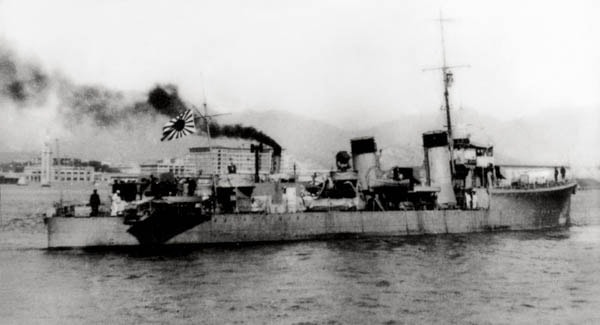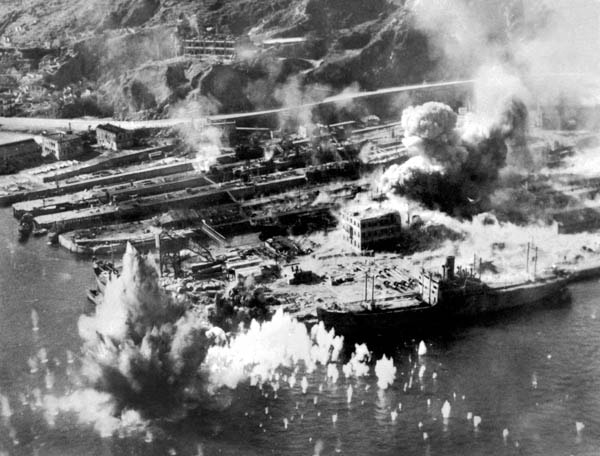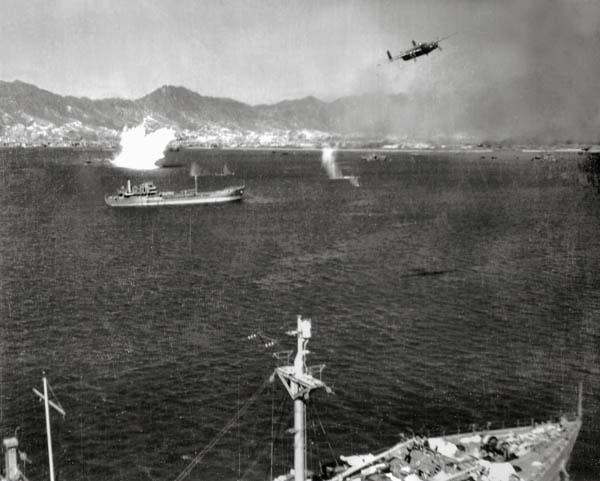Hong Kong is located at the centre of East Asia and South-East Asia. It forms part of a triangular trade route in the South China Sea, geographically being 1,440 miles to Singapore and 640 miles to Manila.[11] In the plan for the Great East Asia Co-prosperity Sphere, Hong Kong, however, had little value to the Japanese Army, as its major importance was to stop strategic goods from being imported to China.[12] Although it had world-class dockyards, Hong Kong’s shipping and naval functions were not utilised because Hong Kong was occupied and administered by the Japanese Army, not the Japanese Navy. Hong Kong was only regarded by the Japanese as a supply and repair depot in East Asia.
The Japanese Army took full control of Hong Kong, while the administration of the port was placed under the supervision of the martial regime’s Department of Communications.[13] As the Second China Expeditionary Fleet of the Japanese Navy set up the Hong Kong Special Naval Base after the occupation of Hong Kong, the navy also played an important role in patrolling and administering the port of Hong Kong. According to an agreement made between the Japanese Army and the Japanese Navy on the control of Hong Kong in May 1942, naval facilities including a naval hospital, wharves, truck repairing workshops and assembly houses were established, mainly in the north of Hong Kong Island.[14] The office of the Port Control Unit was situated on Kellett Island, on the site of the clubhouse of the Royal Hong Kong Yacht Club, which had opened in October 1940.[15] Near the end of the war, the station on Kellett Island also functioned as the material depot for the Japanese Navy.[16]
The Port Control Unit took care of the administrative duties, doing more or less what the Harbour Department had done before the war. It was responsible for the general operation of the harbour, assigning anchorages, patrolling, managing buoys and navigational aids along the Pearl River shores, and preparing for returning ships. Besides these normal duties, the office was also assigned to handle military duties, such as escorting water transports, training seamen for the navy in Hong Kong, and quarantining the unit’s craft and aircraft.[17]
Treating Hong Kong as its supply and repair depot, the Japanese martial regime constructed nothing but the runway of Kai Tak Airport and a few dockyard facilities for the port of Hong Kong.[18] At least 13 dockyards were still in service until early 1945. The most significant facility added by the Japanese was a new slipway built on the site of the former Naval Dockyard at Admiralty in early 1944. During the war, only small additions like a boathouse were made. In fact, Hong Kong had served as a repair and assembly base for the Japanese Navy since early 1942, with many flagships, gunboats and high-speed vessels stationed there.[19]The Japanese removed a number of mooring buoys from Hong Kong and relocated them to Hainan and elsewhere. More than ten buoys were still in use in 1944, while a further 20 might have been sunk during hostilities.[20]
In early 1944, the Allied Forces began to deploy aircraft to bomb Hong Kong as part of their counter-offensive in the Pacific War. In some cases, Allied aircraft were intercepted and shot down by the Japanese aircraft before entering Hong Kong airspace.[21] Nevertheless, Hong Kong’s major dockyards incurred heavy damage from Allied air-raids, while some residential areas and facilities suffered collateral damage. The most significant air attack was on 21 January 1945, when some 300 aircraft were deployed, damaging over 500 buildings in Wan Chai and reducing the district to ruins.[22]
Notes:
- [11]W. J. Hinton, Hong Kong’s Place in the British Empire, Journal of the Royal Central Asian Society, vol. 28, 1941, pp. 256-69.
- [12]Japan’s Decision for War: Records of the 1941 Policy Conferences, ed. by Nobutaka Ike (Stanford: Stanford University Press, 1967).
- [13]《總督部公報》(香港:香港佔地總督部,1942-1945)。
- [14]《香港ノ警備並ニ軍政実施ニ関スル香港占領地総督第二遣支艦隊司令長官間協定覚書》(昭和17年5月[1942])。
- [15]《海軍根拠地施設(海軍港務部施設)設定地区に関する覚書》(昭和17年5月 [1942年])。
- [16]British Army Aid Group, British Army Aid Group Drawings (Hong Kong: Hong Kong Museum of Coastal Defence, 2010).
- [17]《香港港務部戦時日誌》(昭和19年4月1日~昭和20年5月31日 [1944-1945])。
- [18]吳邦謀:《再看啟德 ── 從日佔時期說起》(香港:涉谷出版社,2009)。
- [19]《第2遣支艦隊戦時日誌戦闘詳報》 (昭和16年12月1日~昭和18年5月31日[1941-1943]);《第2遣支艦隊戦時日誌》(昭和18年6月~昭和20年1月 [1943-1945])。
- [20]British Army Aid Group, An Outline of Conditions in Occupied Hong Kong (Hong Kong: British Army Aid Group, 1945); ‘Hong Kong war archives’ (Hong Kong: The University Library of the University of Hong Kong, 1942-1945).
- [21]《第2遣支艦隊戦時日誌戦闘詳報:航空戦》(昭和19年4月18日[1944])。
- [22]蔡榮芳:《香港人之香港史,1841-1945》(香港:牛津大學出版社,2001)。





